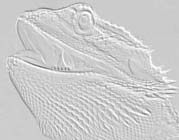 |
 |
|||
 |
||||
|
Known Eye Conditions Droopy
Eyes (Bloodhound Eyes): Hypovitaminosis
A: Early on, there is some swelling of the eyelid, some mild swelling around the iris, and some tearing of the eye in cases of hypovitaminosis A. In addition, there are changes in the orbital glands. As the condition progresses untreated, the swellings become more pronounced and the conjunctiva becomes visible, swollen and reddened. Reptiles that depend on sight to feed can no longer see well enough to feed, and slowly starvation sets in, further weakening the animal. Along with the necessary correction of the diet and environment, and the administration of vitamin A, the cellular changes in the cells of the eye cause the already stressed beardie into infection. So, the application of a suitable topical antibiotic ointment is recommended. During recovery, artificial tears may also be useful. (Ciprofloxacin and similar opthalmic drops have been recommended over gentamicin drops because of a reported epitheliotoxic (kills epithelial cells) effect of the latter.) Parasites: Puffed-Out
Eyes - Pre-Shed: Later, once the old skin is ready to break and start coming off, beardies will often rub their closed eyes against something in their enclosure or area. This might be to soothe an itch associated with the coming shed, or might be done to help gently break the skin so that the final step in the shedding process. Mist your beardie during pre-shed and shed times to help keep the skin moist and easy to shed. Swollen/Distended
Eyeball: Infections
Causing Ocular Changes: Viral infections Pox virus (generally identified by the appearance of small, white papules on the skin; may be seen earlier in the palpebral integument) Herpesvirus (generally in conjunction with proliferative and ulcerative skin lesions) Bacterial infections (Aeromonas, Pseudomonas, Pasturella, Salmonella) Other
Diseases of the Eye: Corneal lesions (caused by accidental injury to the eye, such as rubbing against a rough branch, improperly concealed nail or screw in the enclosure, or scratched by a claw or tooth) Corneal deposits (lipids, often secondary to an underlying eye or general health problem) Uveitis (may be related to bacterial infection) Hypopyon (may be related to bacterial infection) Cataracts
Primary source of information: Melissa Kaplan's website (www.anapsid.org) |
||||
| This information should be used only as a reference tool and should not be used in place of vet assistance. My views and opinions are the result of hours of dedicated research. But remember, I am not a professional. If you have a sick beardie and don't know what to do, don't play God, take him to the vet immediately. | ||||
|
Copyright
© Beautiful Dragons. All Rights Reserved.
This website may not be copied or reproduced without my permission. |
||||